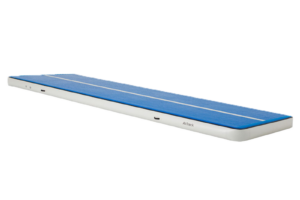Quality Cheerleading Equipment Promotes Safer Practices
Cheerleading has become one of the most competitive sports in the country, and it’s no surprise. Contemporary cheerleading features exciting stunts and tricks that captivate audiences across the nation, and has even sparked a trend for cheerleading movies, camps, and blogs. Cheer teams are setting increasingly high standards for the sport, incorporating new and difficult gymnastic stunts that require training, practice, and appropriate cheerleading equipment. In fact, the National Athletic Trainers’ Association has just created a series of guidelines aimed at protecting cheer athletes across the country. In response, cheerleading equipment manufacturers are offering a range of products suited towards setting up safer gyms, and coaches are using a variety of new techniques and safeguards to keep athletes healthy. Cheerleading is now regulated at the middle school, high school, and college levels. The American Association of Cheerleading Coaches and Administrators’ now offers guides and education to help keep the community safe. Cheerleading teams in the NCAA now require coaches to get a safety certification. Consequently, injury rates, including concussions and sprains, have significantly decreased since 2006. This article explores how new equipment can help promote safe practices for your cheer squad.
The Use of Landing Pads and AirTracks in Stunt Training
Good cheerleading equipment starts from the ground up. The National Cheer Safety Foundation reports that roughly 93 percent of cheerleading injuries occur on hard gym flooring, concrete, or on surfaces that are not adequately covered by supportive mats or crash pads. Many of these injuries happen while a squad is performing or practicing stunts, like pyramids, shoulder sits, basket tosses, or other stunts involving a flyer, without proper cheerleading equipment. Since stunting is becoming more popular, it’s crucial that teams use appropriate AirTrack or mats during training in order to prevent injury. How to decide what type of flooring equipment is needed? Start by considering the difficulty of the stunt, and then consider the height at which the stunt is performed. Stunts performed at a higher range equal a greater risk, thus a greater need for protective mats and floors.
The Latest Innovation in Cheerleading Equipment such as Flooring


Safety Mats: The Flyer’s Best Friend
During cheerleading training, safety mats are often used to support flyers that are dismounting from a stunt or landing a tumbling trick. These mats are anywhere from eight to thirteen inches thick, and are made of a high-density foam that helps support an athletes as they land, or provides cushion in the case that they accidently fall. Cheerleading coaches often combine mats with an air track in order to provide an extra layer of support during cheerleading tumbling or stunting training. Safety mats are not typically lightweight, but their smaller dimensions make it easy to store and transport them. They are covered in an easily washable and repairable material that is designed to withstand repeated blows. Every cheerleading team should practice with adequate mats, and with such a great range on the market, there’s no excuse to go without.
Portable Mats for Safer Home and Outdoor Cheer Practice
Manufacturers are now addressing the market for home and outdoor cheerleading equipment by offering smaller-sized air track and folding mats. A good home air track has all the benefits of a regular-sized air track, except it is smaller, lighter, and more affordable. A folding floor mat is also a great option and can often be customized to your cheer team’s colors. Opt for an option that is made with good quality foam and durable vinyl; it may require a greater investment upfront, but will last for several seasons. Cheerleaders can use this equipment to more safely practice tumbling while on the road, or in an outdoor setting. While it’s not advised to attempt stunting or tumbling outside of a supervised setting, enthusiasts can practice the basics at home knowing that they have a greater level of protection and joint support on the mat.
AirRolls to Support Balance in Preparation for Stunts
Flyers need to have excellent balance to keep themselves and their team members safe. Have your team take turns standing on the airroll– they’ll have to keep their core engaged in order to keep stable. Airrolls are a great tool for cheerleaders to develop core strength while practicing balance, and supporting the strengthening of the muscles surrounding the ankle. Though simple, this piece of cheerleading equipment is great for athletes to use in between routines, during warm ups, or during down time.
Upgraded Cheer Stands Support Balance and Ankle-Strength
Today’s manufacturers are offering an upgrade on the wooden or metal cheer stands of the past. Contemporary models are made with durable, lightweight materials and offer a more stable base. These can be used to practice balance, and to support ankle strength during training.
Airramps for Joint Support During Tumbling
Use wedges and airramps in your floor set up to provide a safer experience as athletes tackle complex tricks like backsprings and flips. Wedges can be set up in combination with airfloors and landing mats in order to provide support for cheer athletes that are attempting to learn specific tricks and tumbling moves.
Other Tips for Preventing Injury
No matter what equipment you decide to purchase for your team, there are a few guidelines to keep in mind when it comes to preventing injuries. Use this injury-prevention checklist to keep your athletes safe:
Focus on Building Strength & Endurance
Strong muscles and joints are the first step to preventing injury. Stamina and core strength are key to consistently practicing good form and landing stunts. As soon as an athlete gets tired, they are at greater risk for injury.
Use The Right Equipment
Use the correct flooring and mats recommended for the type of stunts your team is working on. Make sure they are adequately sized, properly inflated, repaired frequently, and safely stored.
Read Safety Guidelines
There are several guidelines and training courses available to ensure that you’re following the best safety precautions. The Pop Warner Rules Book, the Youth Cheer and Dance Alliance, the NCAA, and the American Association of Cheerleading Coaches and Administrators’ all offer extensive guides and documentation.
Don’t Practice Without a Spotter
When learning stunts, ensure you have properly trained spotter present and focused at all times. In the case that someone does fall, you’ll have a team ready to spring to action.

 408-569-9504
408-569-9504




